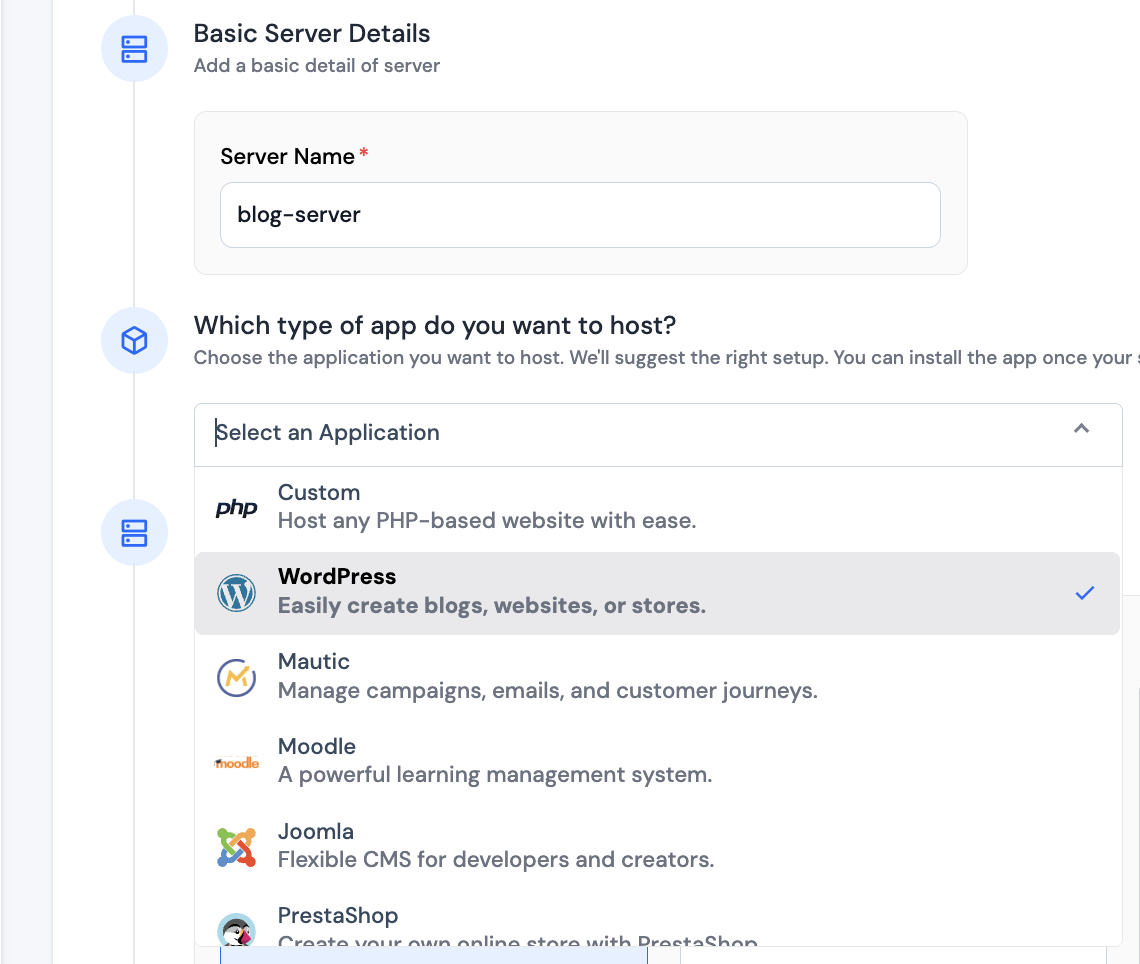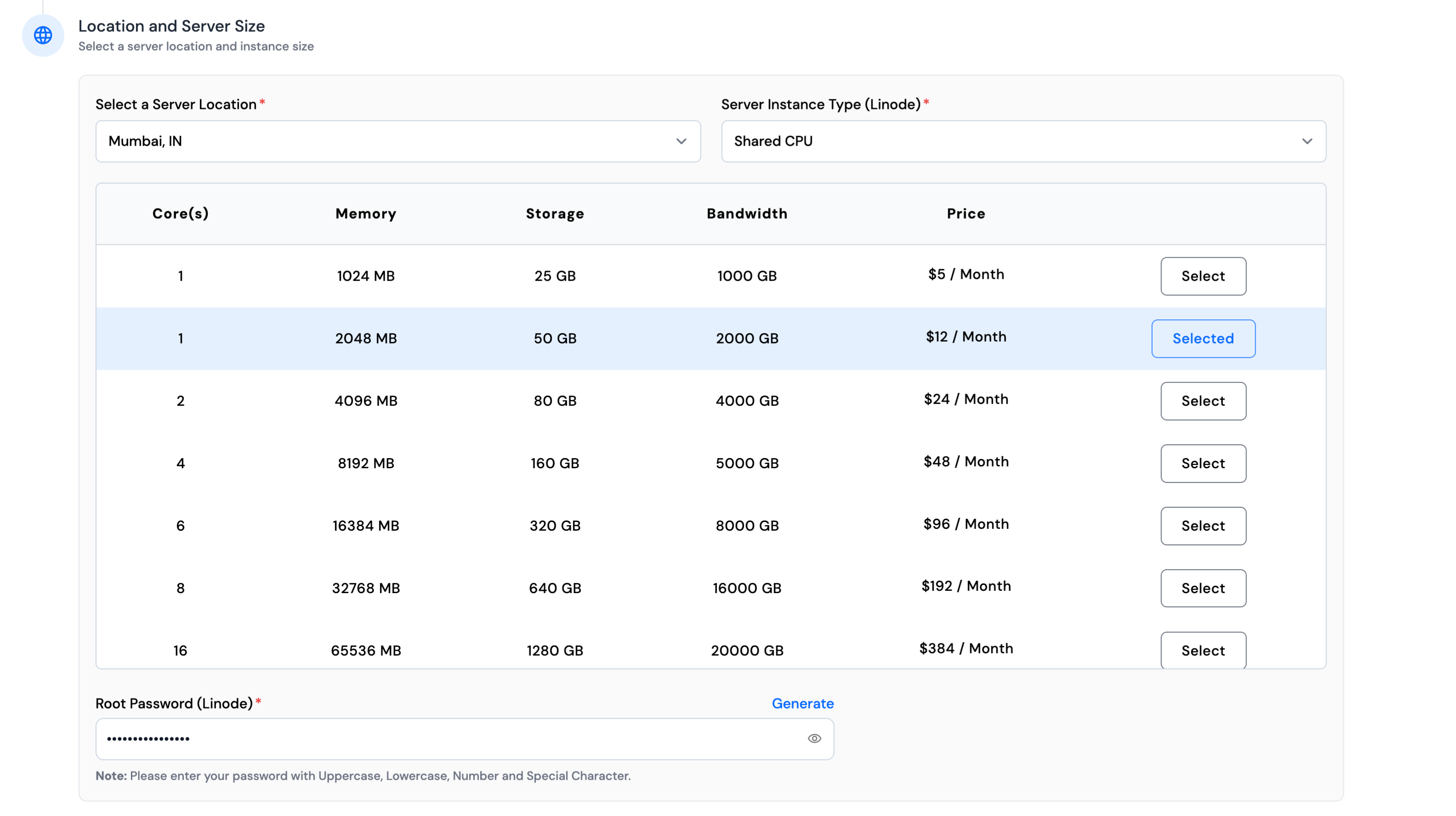Linode
Linode is a well-established cloud infrastructure provider that focus on simplicity, reliability, and high-performance cloud solutions. Linode offers Virtual Private Servers (VPS) designed to scale with users' unique requirements, providing flexible computing solutions. These VPS instances are available in various configurations, allowing users to customize CPU, RAM, storage, and bandwidth based on their requirements.
Here is the step-by-step process to connect Linode with ServerAvatar:
Step 1: Log in to your ServerAvatar account and click the Create → Server button at the top-right corner of the dashboard.

Step 2: Select Self Server as the server type.

ServerAvatar provides below options of create an account on Linode or to link an account if you already have an account.
-
Connect Existing Linode Account: If your Linode account is already linked to your system, you'll find it listed in the options. Simply select your account from the provided list, as shown in the below given image.
-
Link Linode Account: If you already have a Linode account but haven't linked it yet, use the below provided link to connect your Linode account with ServerAvatar.
- Create a New Linode Account: For new users without an existing Linode account, click on the "Create an account" option. This will redirect you to the Linode signup page. Once your account is set up, you can proceed to connect your Linode account with ServerAvatar.

Step 3: Once you’ve selected your Linode account, enter a Server Name of your choice.
Step 4: Select the Application Framework you intend to host. Based on your selection, ServerAvatar will recommend the appropriate setup.
Note: This field is optional.

Step 5: Pick your desired Tech Stack, Operating System Image, and Database.
When selecting your tech stack, consider the specific requirements of your project. If you choose the Node Stack, please note that MySQL and MariaDB are not compatible with this stack.

If you need Node.js, enable the corresponding toggle.
If you select the Node Stack, the Node.js toggle will not be visible as it is already included.
You can also enable Yarn installation by toggling the Install Yarn Along with Node option, if you select Node Stack as your web server.

Step 6: Choose an SSH Key:
- Generate a new key: This will create a new private-public key pair for secure access.
- Add a public key: If you already have an SSH key, you can add the public key to the server to use your existing key.

Step 7: Select a Server Location and Size.
Pick a Server Location (region) based on where your target users are located. Then choose the appropriate Server Size based on your required CPU, RAM, storage, bandwidth, and cost.
In this step, you will also need to provide a Root Password for your Linode server. Make sure to keep this password secure as it grants root-level access to your server.
This password must meet the following criteria:
- At least 11 characters long
- Includes uppercase & lowercase letters, numbers, and symbols
- Avoids dictionary words, patterns (e.g., "abcd", "1234"), and repeats (e.g., "aaa")

Step 8: Click the Deploy Server button to begin the setup.

Installation Process
During installation, you will see which services are being installed and configured in real-time. ServerAvatar will perform the following steps:
- Install a web server (Apache, Nginx, or OpenLiteSpeed)
- Install PHP and all supported versions (from 7.2 to 8.4)
- Install and configure PHP-FPM
- Install and configure MySQL
- Install and configure Redis
- Create a SWAP memory file
- Create basic virtual host files
- Install Git and Composer
- Finalize the setup and perform testing
The entire installation typically takes 5 to 15 minutes. Once complete, your server will be fully configured and ready to host PHP/WordPress sites directly from the ServerAvatar panel. This is how you can connect an Linode server with ServerAvatar.